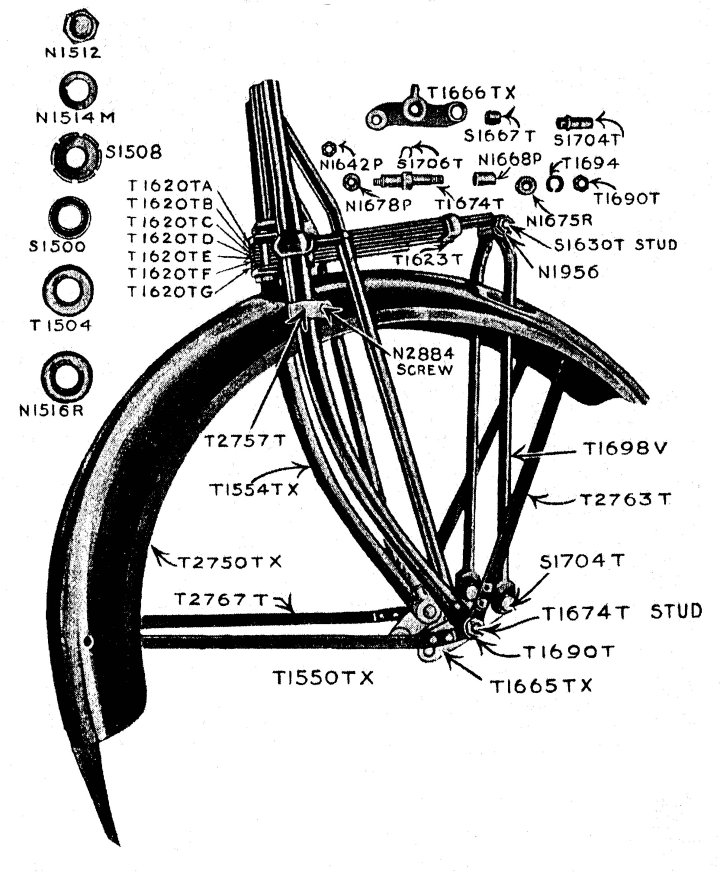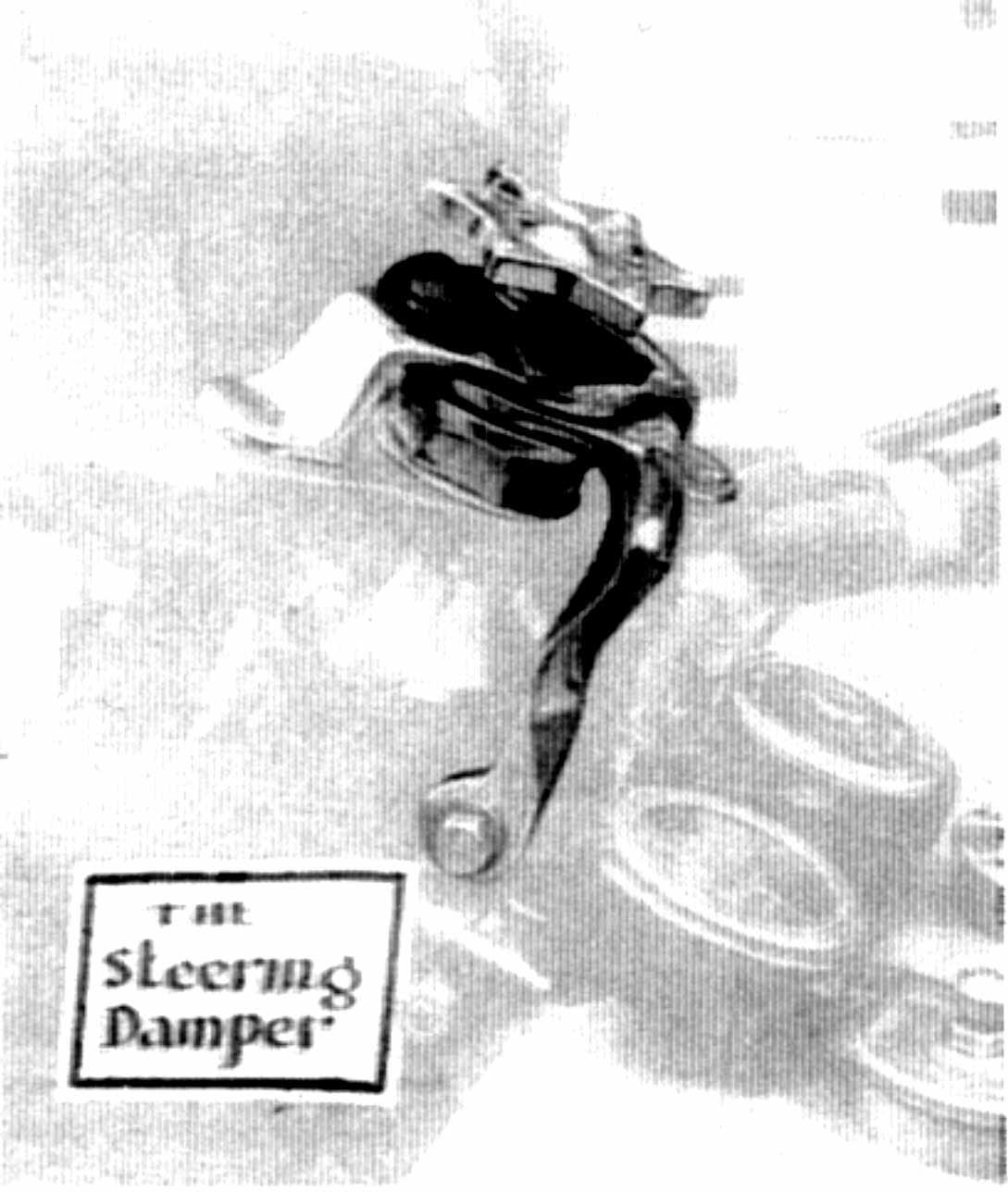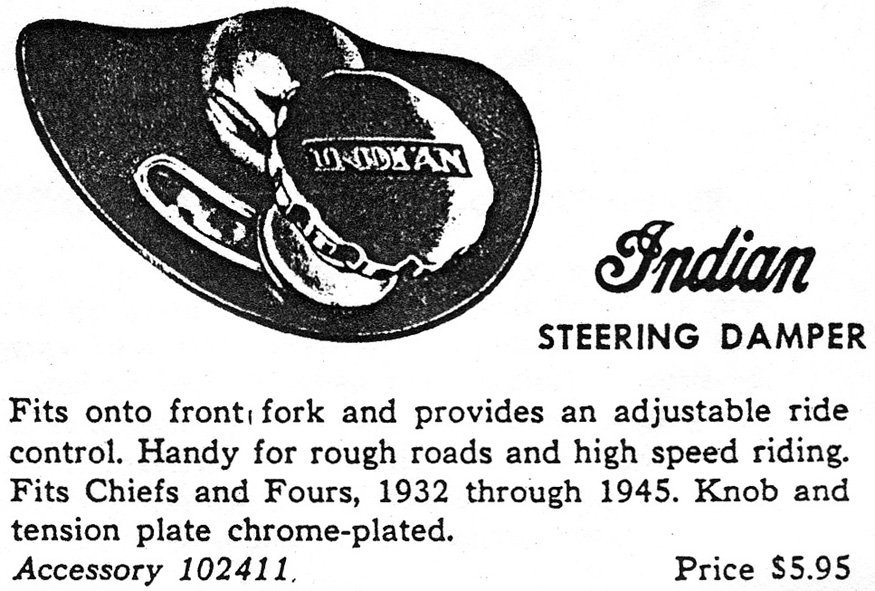| |

| Indian Chief Leaf Spring Forks by Andy Donald |
INDIAN CHIEF FORKS 1924 -1945
When I was running the Club Spare Parts Scheme I received several phone calls from people who had problems with their leaf-spring forks, and mainly this was due to lack of knowledge about them. These inquiries led me to find out more about the forks
myself. I’m sure all of you who are reading this are
generally familiar with leaf-spring forks, but how do you distinguish one set from another? In this article I hope to answer that question, though I only cover the forks fitted to Indian Chief models from 1924 onward, and do not include the earlier bell-crank forks. I have not researched the 101 Scout forks at all, but include the 1932 Standard Scout which had the Chief frame. I understand the Four-Cylinder models had the same forks, but cannot be absolutely sure that they were identical. I have not quoted part numbers anywhere; you can look these up for yourselves in the parts catalog. The Chief leaf-spring fork dates from a mid-1924 factory re-design of the old 1910 trailing-link fork. This had bell-crank rockers that pushed up on the spring. These can be seen on the Hedstrom F-Head and Powerplus Indians, and were used on the early Chiefs up to 1923. The new fork had straight bottom rockers (but still referred to as “bell-cranks” in the parts books), set with an increased angle to the links. These rockers work the opposite way to the earlier forks, and pull down on the spring. The purpose of the re-design was to handle the increased weight of the new cycles, and the factory claimed it gave a softer
ride when combined with the new “balloon” tyres. The basic fork assembly consists of a solid-mounted
girder (called the “fork front frame” in the parts
book), with rockers on either side at the bottom. Suspension is provided by a quarter-elliptic laminated leaf-spring clamped to a cast yoke below the steering head. This spring can be adjusted in or out of the clamp by about an inch to vary the spring rate. The spring is joined to the rockers by connecting links either side of the front wheel. A word of warning here: these links vary slightly in thickness at the top (where they join the spring) for different years. The Indian Parts Catalog lists four different lengths of link to spring stud, and several different spacers to compensate for this. Make sure you fit the correct combination. The handlebars have a central casting which fits over the top of the girder and steering stem, acting as a top yoke. I have shown a comparative sketch of the fork girders from 1924 to 1945, with key dimensions, at the end of this article.
1924 -1931 FORKS
The 1924-31 forks and steering head are shorter than the later ones, so the forks are not interchangeable with the later frames. Mudguards are attached to the fork with clips. The top and bottom steering head bearings are Indian cup-and-cone assemblies. The
upper bearing has 21 loose 1/4” balls, while the lower has 20 5/16” balls. Bearing play is adjusted on the
upper cone, and locked with the upper cone nut and lock-washer. These bearings are not interchangeable with the later 1930s/40s forks.
 |
Illustration from 1920s parts list (Starklite Cycle) |
1924-31 FORK SPECIFICATIONS:
26½ inches long. Internal width at bottom 7¼“ 7 spring leaves, 2” wide. Overall length 12½” Mudguard mounting clip 3½” below the side brace.
Headlamp mounted on struts bolted to the handlebars. Accessory klaxon horn clipped to the handlebars or to left side of the frame.
1928: front drum brake introduced with plunger style anchor, as on the 101 Scout.
1932 -1939 FORKS
In 1931 Indian presidentPaul DuPont assessed the Chief model, condemned it as old-fashioned, and ordered design changes to update the cycle. As part of this modernisation the frame and forks were redesigned in 1932 to give the classic look we are used to with American motorcycles today: the tall front end, wide bars, low seat-height and two “fat-bob” fuel tanks. It was in fact influenced by British motorcycle design of the time, but came out as a uniquely American solution. The new leaf-spring fork of 1932 was longer and wider than the 1920s one, with eight wider leaf springs. See the specification for details. In 1935, as most Chief owners know, there was another major design update at the Indian factory. The new Briggs Weaver streamlined mudguards were introduced, along with larger 4.50 x 18 tyres. Mounting tabs were re-located and welded on for the new mudguards. Rebound leaf-springs were added on top of the others to improve handling. Indian also introduced an accessory leather felt-lined “spring oiler” cover, with a brass oil cap, which fits over the
springs to keep the suspension lubricated and free from dust and road grit. This is a nifty little item, and is currently available from Charles Qua in Holland.
 |
The leather spring gaiter with oiler (Charles Qua) |
Another handy gizmo for these forks is the Crocker steering damper. No, not off a Crocker motorcycle; Al Crocker made these especially for Indians. There are two types. The 1932-37 version, and a 1938-45 item designed to fit the late handlebar set-up (see spec. below). I believe reproductions of both of these are still available from Michael Breeding in Santa Fe, New Mexico (www.mikesindianparts.com).
 |
1930s advertisement for the Crocker Steering Damper (Michael Breeding) |
 |
Indian Steering damper from 1948 Accessory Catalog (Tony Leenes) |
During the late ‘thirties Indian were making constant
running improvements and the forks were no exception, particularly as the cycles were getting heavier. See the specification sheet for these updates. In response to complaints that the handling had suffered, particularly when heavily laden, Indian supplied a spring wedge in 1939 to alter the rocker angle as a temporary fix. Details of this can be read in “Indian Chief Motorcycles” by Jerry Hatfield (page 71). Here is Michael Breeding’s summary of the
effect that the wedge has on the suspension: “Jerry Hatfield's 'Indian Chief Motorcycles' introduced me to the importance of the greater than 90 degree angle between the Rockers and Connecting Links of Indian Leaf Spring Forks. It's a safety and ease of ride issue. The upwardly inclined Rockers make for a softer ride because it gives more fore and aft movement of the wheel. More importantly, when the angle is near 90 degrees, the stiffest spring rate for the springs occurs and the leaf springs are deflected more for each incremental movement of the front wheel than if the angle is more or less than 90 degrees. In 1939 (also as a retrofit to heavier machines, and tired springs, of other years) Indian offered a wedge to increase the angle to greater than 90 degrees. This results in a softer ride for the first part of the wheel travel. As the wheel hits bumps, the angle between the rockers and connecting links approaches 90 degrees, thereby increasing the effective spring rate. This results in a smooth ride over small bumps and a progressively stiffer spring action to prevent the fork from bottoming over large bumps. Leaf Spring Forks set-up at a no-load angle of 90 degrees, or less, are made even worse as soon as the machine is mounted by the rider. This results in the stiffest spring action on the smallest bumps and on a large bump an almost instantaneous bottoming as the spring offers less resistance. On recoil, with too little resistance to slow down the movement, the front end is violently heaved upward. This set-up mistake is paid for coming and going.”
1932-34 FORK SPECIFICATIONS:
29 inches long. Internal width at bottom 8¼“.
8 spring leaves 2½” wide; no rebound springs on top.
Overall spring length 12¾”.
Mudguard mounting tab 3½” below the side brace.
Headlamp mounted high to lug cast on handlebars. Horn mounted below lamp on a bracket clamped to the springs, forming part of the steering lock. Rockers have 7/16” axle holes. Wheels are non-interchangeable.
1932: Front brake plunger anchor retained.
1933-34: New front brake plate and anchor arm: 3” long between centres.
1935-39 FORK SPECIFICATIONS:
29 inches long. Internal width at bottom 8¼”.
10 spring leaves 2½” wide; two rebound springs on
top. Overall spring length 12¾”.
Mudguard mounting tab 4½” below the side brace.
1936: “Solid” steering head re-design. See “Indian
Motorcycle Restoration Guide” for details.
1937: Rockers have larger axle holes for the new
interchangeable wheels: RH 3/4”, LH 9/16”.
1938: Handlebars re-designed for the following changes: Headlamp mounted lower on a pedestal and fork shield plate above the spring. Horn mounted above the lamp on a handlebar bracket. A cover plate goes over the new handlebar central casting.
1939: 11 spring leaves; an extra rebound spring on top. Spring wedge introduced to alter the rocker angle, and the bottom spring leaves strengthened.
1940 -1945 FORKS
The skirted fender Chief introduced in 1940 naturally required another major re-design of the forks, with altered geometry and dimensions to cope with the heavier spring frame and wider wheels and mudguards. Overall the forks are longer, with a larger spring. The rake was increased, and the bottom of the forks modified to compensate. A small lug at the lower end of the forks for the skirt mounting is found on the civilian models only. The steering head on the
1940s spring frame is the same length (7¾”), and has
the same internal dimensions as the 1930s rigid frame. Although this means the 1930s and 1940s forks are interchangeable, it will adversely affect the geometry and handling if the wrong forks are fitted to the wrong frame. Once again, check out the specifications. When the 841 style girder forks were introduced in 1946 to further improve handling, Indian also altered and shortened the steering head. The leaf-spring fork can NOT be fitted to the 1946-53 frames without serious modification. Be warned!
1940-45 FORK SPECIFICATIONS:
31 inches long. Internal width at bottom 1940: 8¼”
1941-45: 8⅜”
11 spring leaves 2½” wide, no wedge. Overall spring
length 13¾”
Fender mounting tab 5½” below the side brace, with
skirt mounting lugs at the bottom on civilian models
only.
New headlamp mounting pedestal.
Longer brake anchor arm to clear the skirt: 4⅛”
between centres.
1941: Fork made 1/8” wider for the wider mudguard
and optional 16 inch wheels. Fork shield extended down over springs.
 |
1937 -1939 Interchangeable front wheel, also used on the 1940 and military Chiefs. (Jerry Hatfield) |
1944: According to Jerry Hatfield the lower end of the fork was extended to increase the rake (a last-ditch attempt to improve handling of the now antique fork). However, I asked Bob Stark for information on how much this extension was, and he replied that he knew of no differences between the 1940s forks, so if anyone can give a definitive answer to this one, with the length of the extension, please let me know.
(I had no response from the first publication of this article, so I'm still waiting to hear if anyone can clarify this point).

STEERING HEAD BEARINGS 1936-1945:
TOP BEARING: This is an Indian adjustable cup-and-cone bearing, obtainable only from Indian motorcycle suppliers. It consists of a bearing cup which fits into the steering head, 21 loose balls, and a large adjusting cone fitting over the top. Once the steering head play has been adjusted with the cone, the whole assembly is locked by the cone nut and lock-washer. Taper roller conversions are offered by several Indian suppliers.
BOTTOM BEARING: This is a proprietary thrust ball-bearing, U.S. No. 7206W, which can be replaced by a Timken taper-roller bearing: Inner No. 08125, Outer No. 08231. There is a large flat washer/dust shield which must be fitted below the bearing (don’t forget it!).
Comparative Chief front fork girders 1924 – 1945
SOURCES:
Fred Woodgates’ 1925 Indian Chief. Andy Donald’s 1938 Indian Chief bobber. Phil Clarke’s 1940 Indian Chief.
BIBLIOGRAPHY:
Indian Factory Parts and Accessory Catalogs.
Indian Motorcycle Restoration Guide 1932-53:
Jerry Hatfield.
Indian Chief Motorcycles 1922-53: Jerry Hatfield.
Indian Photographic History: Jerry Hatfield.
The Indian: Tod Rafferty.
The Iron Redskin: Harry Sucher.
Motorcycle Engineering: Phil Irving.
ACKNOWLEDGEMENTS:
Thanks to Michael Breeding for information on the Crocker Steering Damper and Indian spring wedge, and for proof-reading this article.
Thanks to Bob and Gary Stark for technical information.
Thanks to Charles Qua for photograph of spring oiler.
Thanks also to Todd at Jerry Greers Engineering for his excellent online catalog
Andy Donald 

|
|
Disclaimer: Whilst every effort is made to ensure the accuracy of the information provided, neither the Indian Riders Motorcycle Club, it's officials or any individual shall in any way be liable for loss, injury or damage resulting directly or indirectly from reliance of such information. The inclusion of adverts does not mean that the advertisers are in any way endorsed by Indian Riders Motorcycle Club or it's officials. Any disputes or claims must be taken up with the advertiser. |
|